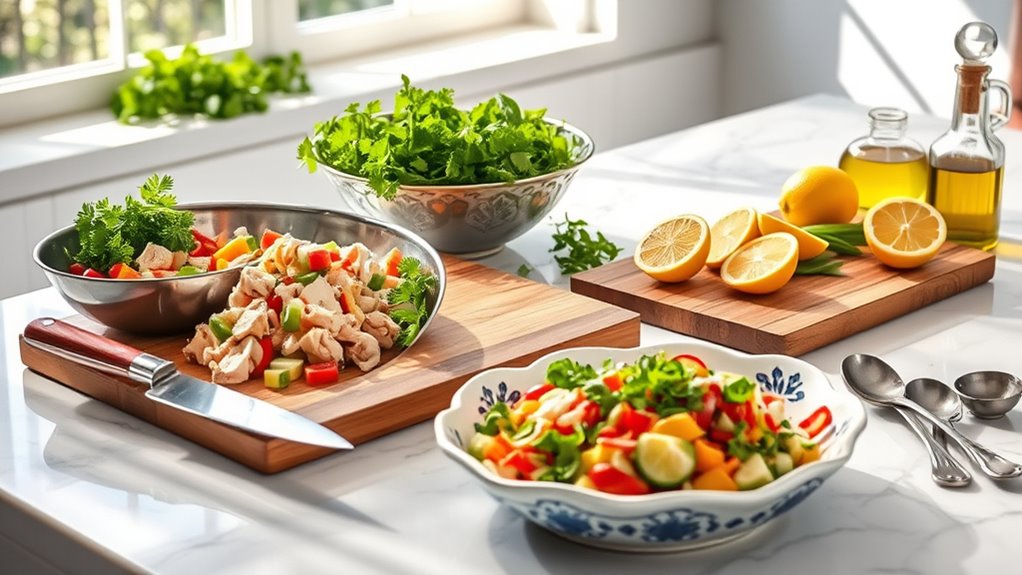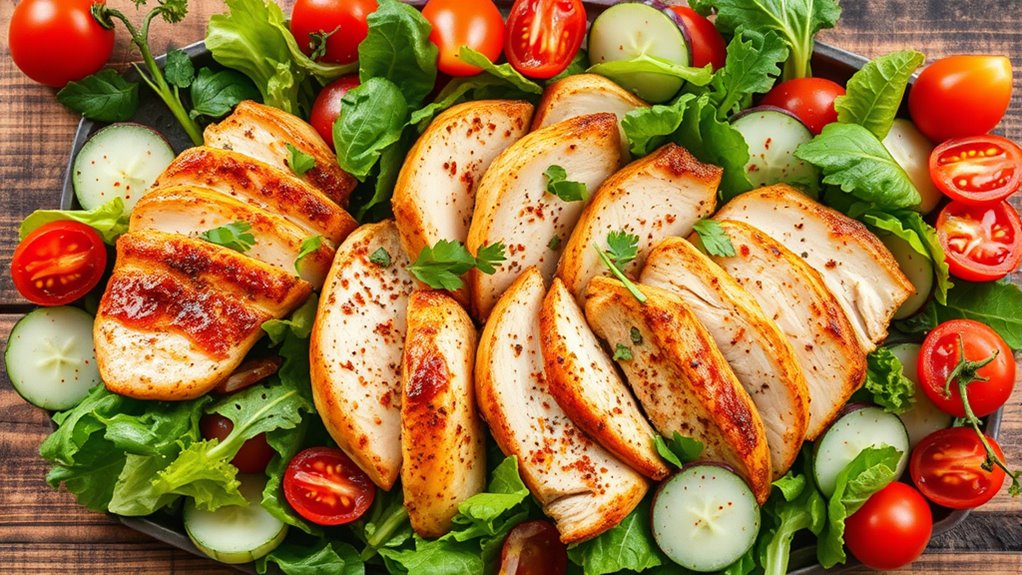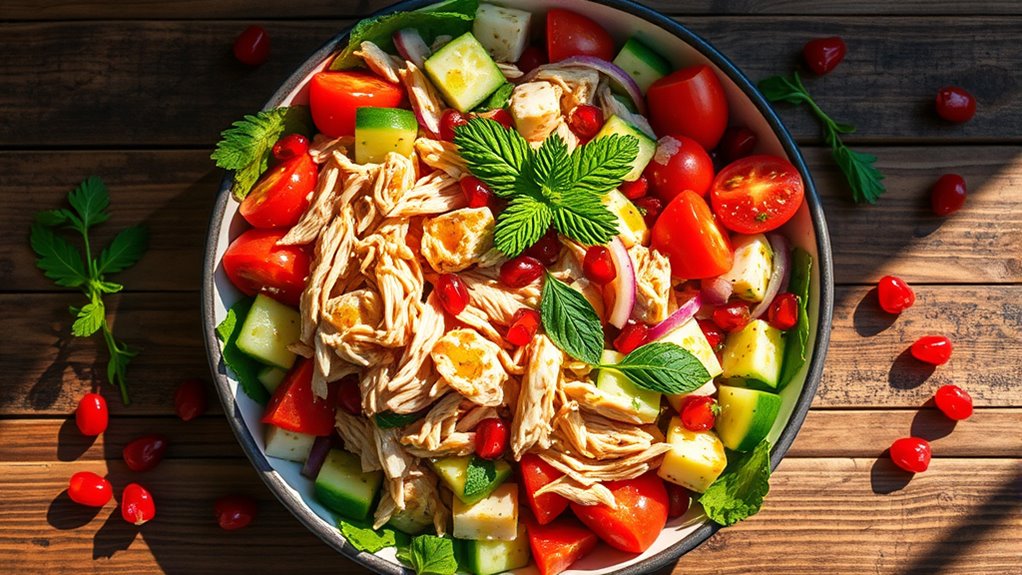In this Turkish chicken salad, you’ll sear tender chicken breasts until golden, then slice against the grain for extra juiciness. Toss them with crisp cucumber, juicy tomatoes, and a bright lemon-olive oil dressing, finishing with a sprinkle of fresh herbs. It’s a balanced plate: high-protein chicken, fiber-packed veggies, and vitamin-rich produce, all light yet satisfying. A quick, flavorful option to brighten your table, with simple steps that hint at even more flavor to come if you keep exploring.
Ingredients and Quantity

Here’s a concise list of the ingredients and their quantities for the Turkish Chicken Salad:
You’ll assemble a vibrant base to let flavors breathe, then tailor a bright balance with a simple chicken marinade and a tangy salad dressing. Keep the measurements exact to honor precision and freedom in your kitchen.
| Ingredient | Quantity |
|---|---|
| Chicken breast, boneless | 2 fillets (about 12 oz) |
| Olive oil | 2 tbsp |
| Lemon juice | 1 tbsp |
| Cucumber, diced | 1 cup |
| Tomatoes, chopped | 1 cup |
| Red onion, thinly sliced | 1/2 small |
This setup invites you to marinate just enough to kiss the meat, then dress with your preferred salad dressing to taste.
Preparations

Now that the ingredients are measured, it’s time to prep them methodically. You approach each component with care, aligning steps for steady flow. Begin with chicken, verifying doneness and slicing against the grain for tenderness that holds texture. Next, rinse vegetables swiftly, pat dry, and julienne or dice as your recipe directs, keeping sizes uniform for even coating. For herbs, chop fine enough to release aroma without overpowering bite. Consider ingredient sourcing as part of the workflow: select fresh, local produce when possible, and choose high-quality olives, yogurt, and lemon for brightness. Maintain clean hands and surfaces to prevent cross-contact. Document any substitutions ahead of time, so your preparation methods stay intentional, not improvisational. Your goal is a balanced, vibrant base ready for assembly.
Kitchen tools or Kitchenware Required

A well-chosen set of kitchen tools keeps your Turkish chicken salad efficient and consistent. You’ll reach for a sturdy cutting board and a roomy salad bowl to build texture without mess. A sharp knife handles chicken and vegetables, while tongs or a large spoon coats ingredients evenly. Keep a measuring spoon handy for dressing balance, and use a whisk to emulsify oil and lemon juice. A colander helps rinse greens, and a grater adds subtle zest. Table below paints the scene:
| Tool | Purpose |
|---|---|
| Cutting board | Prep surface for chopping |
| Salad bowl | Toss and present salad |
With these essentials, you’ll move freely, creating a confident, flavorful mix every time.
How to Cook

- Season chicken breasts with salt and pepper.
- Sear the chicken in a hot skillet until golden and just cooked through.
- Rest the chicken briefly to retain moisture.
- Slice the chicken thinly for an even texture.
- Use steady, controlled heat during cooking to avoid drying out the meat.
- Optionally, brush the chicken with olive oil during searing for added flavor.
- For extra brightness, marinate the chicken briefly in lemon juice and sumac before cooking.
- After resting, chunk the chicken instead of shredding to preserve its bite.
- Focus on balanced cooking techniques: proper sear, precise timing, and gentle handling.
- Season simply with salt, pepper, and optionally a pinch of paprika or cumin.
- Fold the chicken into fresh ingredients.
- Toss gently, allowing the aromas to guide the final mixing.
How to Serve

With the chicken cooked and rested, it’s time to plate the Turkish Chicken Salad in a way that showcases the flavors and textures you’ve built. You’ll arrange crisp greens as a bright base, then nest the chicken, cucumber, tomatoes, olives, and feta in clean, deliberate layers. Drizzle a light lemony-olive oil dressing, letting the geometry of colors guide the eye. Keep proportions balanced so each bite delivers tang, salt, and herbaceous lift. Use a generous sprinkle of fresh herbs—parsley or mint—to finish the aroma. For garnishing ideas, scatter toasted sesame seeds or slivered almonds for crunch, and a final squeeze of lemon. Serving suggestions include warm flatbread or a chilled mezze platter to complement the dish.
Tips
Here are a few practical tips to elevate your Turkish Chicken Salad: start with uniform chopping so every bite feels balanced, then let the chicken rest fully before slicing to keep juices in. Choose bite-sized cucumber, tomato, and onion for crisp texture and color contrast. A light yogurt-lemon dressing carries brightness without heaviness, but you can swap in olive oil and red wine vinegar for a tangier note. For healthy substitutions, use pre-cooked but still juicy chicken breast and mix in finely chopped herbs like dill and mint for aromatic lift. Flavor enhancements come from a pinch of sumac or paprika, a whisper of garlic, and a dusting of sesame seeds. Serve chilled for a rejuvenating finish that feels both vibrant and disciplined.
Food Value and Benefit
This Turkish Chicken Salad offers a well-rounded nutritional profile that supports overall health and daily energy needs. It combines lean protein, fresh vegetables, and hydrating ingredients to create a nourishing and satisfying meal.
Benefits of eating this recipe include:
- High-quality protein from lean chicken promotes muscle maintenance and repair.
- Dietary fiber from fresh vegetables supports healthy digestion and gut function.
- Rich in vitamins A and C, which boost immune health and support skin and eye health.
- Contains minerals such as potassium and magnesium that aid in bone health and electrolyte balance.
- Provides hydration through water-rich ingredients like tomatoes and cucumbers.
- Supports steady energy release with a balance of protein and complex carbohydrates.
- Enhances satiety, helping with mindful eating and appetite control.
- Low in unhealthy fats and heavy dressings, making it a light yet flavorful option.
This salad is a nutrient-dense choice that contributes to immune support, bone strength, eye health, and digestive wellness, all while delivering refreshing taste and texture.
Frequently Asked Questions
Can I Substitute the Chicken With Turkey or Tofu?
Yes, you can substitute with turkey or tofu. You’ll enjoy turkey benefits like lean protein, and tofu alternatives keep the salad light. You’ll notice texture changes, so adjust mayo or herbs to suit your taste and freedom.
What Makes This Dish Turkish in Flavor?
This dish tastes Turkish because Turkish spices define its bright herb, citrus, and sesame notes, while Mediterranean influence adds olive oil and yogurt tang. Like a breeze, you savor freedom through balanced, precise flavors guiding your palate.
How Long Can Leftovers Safely Be Stored?
Leftovers last about 3–4 days in the fridge, based on proper food safety and storage tips. Keep them in an airtight container, reheat to steaming, and don’t taste after reheating to guarantee safe, flavorful enjoyment.
Which Herbs Best Brighten the Salad?
Herbs that brighten it best are parsley freshness and dill brightness. Think of them as sunlight in a bowl; you’ll savor crisp, green notes. You [you] add both, and you feel liberated, vibrant, and invigoratingly clear.
Can I Make This Gluten-Free?
Yes, you can, and you should: opt for gluten free alternatives like certified gluten free mayo and crouton substitutes, while following cross contamination tips to keep prep surfaces clean and your freedom to enjoy the dish intact.
